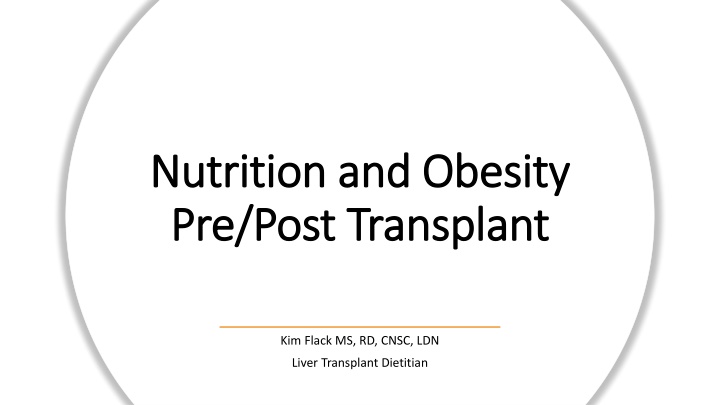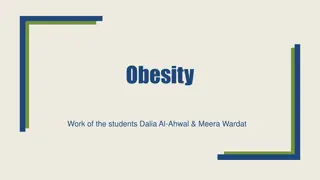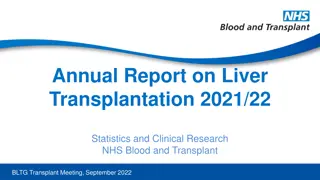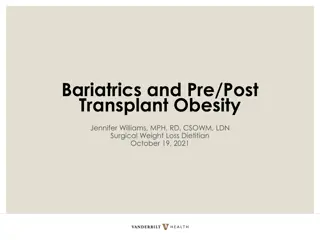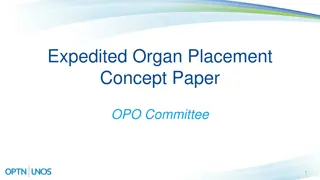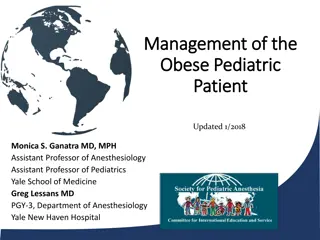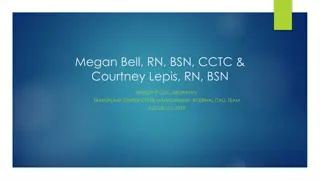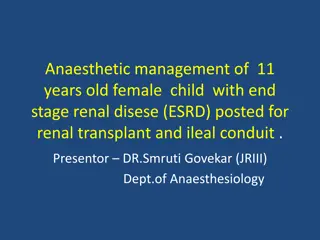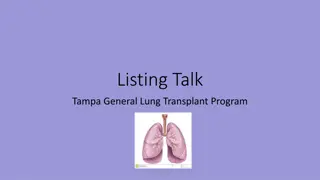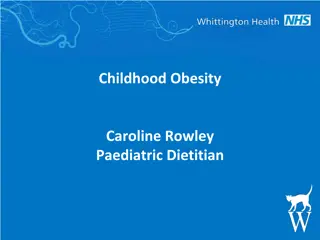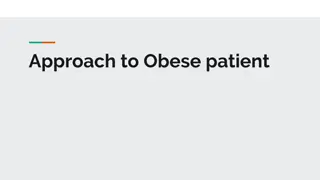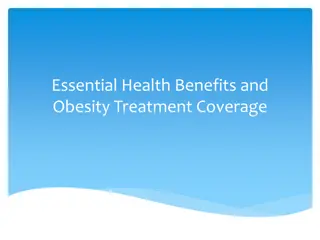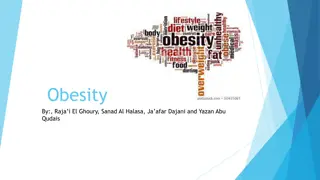Nutrition and Obesity in Pre/Post-Transplant Care by Kim Flack MS, RD, CNSC, LDN
This educational material highlights the crucial role of nutrition in the pre/post-transplant phases, focusing on the evaluation, challenges, and strategies for optimizing nutrition before and after liver transplantation. It addresses the limitations of BMI in assessing nutritional status, the prevalence of malnutrition in transplant patients, and the risks associated with sarcopenic obesity. Practical insights are provided by dietitian Kim Flack to support transplant success and patient outcomes.
Uploaded on Jul 13, 2024 | 7 Views
Download Presentation

Please find below an Image/Link to download the presentation.
The content on the website is provided AS IS for your information and personal use only. It may not be sold, licensed, or shared on other websites without obtaining consent from the author.If you encounter any issues during the download, it is possible that the publisher has removed the file from their server.
You are allowed to download the files provided on this website for personal or commercial use, subject to the condition that they are used lawfully. All files are the property of their respective owners.
The content on the website is provided AS IS for your information and personal use only. It may not be sold, licensed, or shared on other websites without obtaining consent from the author.
E N D
Presentation Transcript
Nutrition and Obesity Nutrition and Obesity Pre/Post Transplant Pre/Post Transplant Kim Flack MS, RD, CNSC, LDN Liver Transplant Dietitian
Topics The pre-transplant nutrition evaluation Optimizing nutrition prior to transplant Strategies/tips on reaching daily intake goals Nutrition challenges during hospitalization Nutrition after transplant
Pre-Transplant Nutrition Evaluation Identify nutrition problems diet intolerance, unintended weight loss, uncontrolled diabetes, malnutrition Complete hand-grip strength frailty, malnutrition assessment Nutrition prescription Nutrition education intervention to support transplant success Identify nutritional barriers to transplant
Does not determine the state of nutrition BMI doesn t tell us any information about behaviors Age, Sex, Race/Ethnicity not considered Does not differentiate between fat and lean body mass. A healthy, muscular person may have a BMI in a high range while a frail, inactive person may have a low BMI with more body fat and less lean body mass Limitations of Body Mass Index (BMI)
Malnutrition Can be undernourished or malnourished and have a high BMI. Malnutrition is universally prevalent among pre-liver transplant patients. Patients with malnutrition have longer hospital stays, increased incidence of ascites and hepatorenal syndrome, as well as increased mortality (Fortier, 2018) Characteristics Reduced energy intake Weight loss Body fat loss mild, severe Muscle mass loss mild, severe Fluid accumulation Grip strength (severe malnutrition) reduced for age/gender
Sarcopenic Obesity A progressive and diffuse loss of skeletal muscle strength, mass and function. The coexistence of obesity and muscle mass loss is known as sarcopenic obesity. Mortality is high in sarcopenic patients waiting for liver transplantation when compared to non-sarcopenic patients. A meta-analysis found that pre-transplant sarcopenic obesity proved to be a risk factor after liver transplant and was associated with two times higher mortality at short- and long- term follow-up (Hegyi, 2020)
Biological syndrome resulting from sarcopenia, inflammation/stress, malnutrition, aging and chronic illness Frailty and Obesity Stay strong optimizing nutrition, cardiac/pulmonary rehab, PT referrals and home-based approaches
Transplant Headlines Clinical Liver Disease 2021, 17;4:271-276 The Impact of Frailty, Sarcopenia, and Malnutrition on Liver Transplant Outcomes
Weight Loss Strategies Energy restriction and exercise are key approaches to weight loss, and we need to ask them about their experiences and help them feel supported. Inadequate energy intake = risk of becoming malnourished When losing weight, make small changes that can be easily maintained. To maintain muscle strength, protein intake must be maintained
Protein Choices Lean cuts of meat, or extra lean ground meats Skinless poultry Low fat or skim dairy products Greek yogurt, Low-fat cottage cheese Beans, peas and lentils Fish baked or grilled Tofu Eggs Nuts and nut butters Oral Supplements
Keep Moving and Stay Active Participate in regular exercise to prevent muscle loss. Exercise helps burn calories and build muscles. As medically appropriate include 3 days per week of moderate physical activity (walking or cycling) for 30 minutes and 2 days per week of light weights.
COVID-19 Nutrition During Hospitalization Obesity increases risk for severe disease and reduced survival Obesity is a chronic low-grade inflammatory state and with illness there is a high risk for loss of skeletal muscle loss and function. Prevention, diagnosis and treatment of malnutrition In critical illness and obesity, energy and protein needs are adjusted based on BMI
Try a liberalized diet approach the best diet is one that patients will eat Offer high protein oral supplements when needed Add high protein snacks Greek yogurt, peanut butter Consult dietitian who can provide nutrition education on the importance of adequate nutritional intakes in the pre-transplant phase. Hospitalized Patient Awaiting Transplant
Nutrition After Transplant Increased demand for nutrients in the acute transplant phase Diet advancement Oral supplement options Nutrition support when needed tube feeding products that have a higher % of protein Provide discharge nutrition education Ongoing nutrition education on obesity prevention and assessment of nutrition status
References Kaur N, Emamaulle J, Lian T, Lo M, Ender P, Kahn J, Sher L. Impact of Morbid Obesity in Liver Transplant Candidacy and Outcomes: National and Regional Trends. Transplantation: 2021,105;5: 1052-1060. Itoh S, Yoshizumi T, Kimura K, Okabe H, Harimoto N, Ikegami T, Uchiyama H, Shirabe K, Nishie A, Maehara Y. Effect of Sarcopenic Obesity on Outcome of Living-Donor Liver Transplantation for Hepatocellular Carcinoma. Anticancer Research 2016, 36; 3029-3034 Buchard B, Boirie Y, Cassagnes L, Lamblin G, Coilly A, Abergel A. Assessment of Malnutrition, Sarcopenia and Frailty in Patients with Cirrhosis: Which Tools Should We Use in Clinical Practice? Nutriments 2020, 12, 186. Hegyi P, Soos A, Hegyi P, Szakacs Z, Hanak L, Vancsa S, Ocsay K, Petervari E, Balasko M, Eross B, Par E. Pre-transplant Sarcopenic Obesity Worsens the Survival after Liver Transplantation: A Meta-Analysis and a Systemic Review. Front Med (Lausanne) 2020;7:599434 Fortier L. Malnutrition, frailty, sarcopenia obesity optimizing nutrition care in liver transplantation. AME Med J 2018;3:22:1-10. Scollard, T. Handgrip Strength Assessment: A Skill to Enhance Diagnosis of Disease-related Malnutrition. Support Line 2017, 39;2:7-13. Duong N, Sadowski B, Rangnekar A. The Impact of Frailty, Sarcopenia, and Malnutrition on Liver Transplant Outcomes. Clinical Liver Disease 2021, 17;4:271-276. Kamo, N, Kaido T, Hamaguchi Y, Okumura S, Okumura S, Kobayashi A, Shirai H, Yao S, Uemoto S. Impact of sarcopenic obesity on outcomes in patients undergoing living donor liver transplantation. Clinical Nutrition 2019, 38: 2202-2209.
